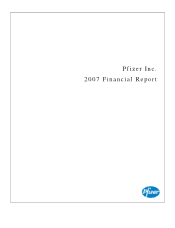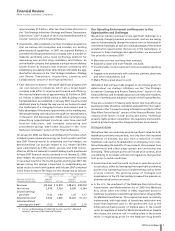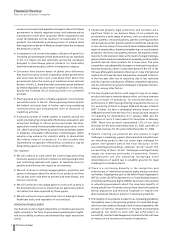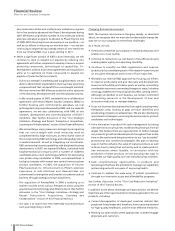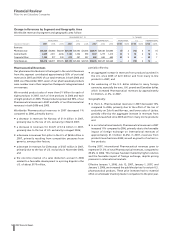Pfizer 2007 Annual Report Download - page 8
Download and view the complete annual report
Please find page 8 of the 2007 Pfizer annual report below. You can navigate through the pages in the report by either clicking on the pages listed below, or by using the keyword search tool below to find specific information within the annual report.
6 2007 Financial Report
Financial Review
Pfizer Inc and Subsidiary Companies
new molecular entities and multiple new indication programs
for in-line products advanced into Phase 3 development during
2007. We expect a significant number of new molecular entities
and new indication programs to advance to Phase 3 by the end
of 2009. With the progress we are seeing in our pipeline — as
well as our efforts in reducing our attrition rate — we are also
continuing to target having a steady stream of new medicines
from our internal R&D, four a year, starting in 2011.
•While a significant portion of R&D is done internally, we will
continue to seek to expand our pipeline by entering into
agreements with other companies to develop, license or acquire
promising compounds, technologies or capabilities. Co-
development, alliance and license agreements and acquisitions
allow us to capitalize on these compounds to expand our
pipeline of potential future products.
䡬Due to our strength in marketing and our global reach, we are
able to attract other organizations that may have promising
compounds and that can benefit from our strength and skills.
We have more than 400 alliances across the entire spectrum
of the discovery, development and commercialization process.
䡬In the second quarter of 2007, we entered into a collaboration
agreement with Bristol-Myers Squibb Company (BMS) to
further develop and commercialize apixaban, an oral
anticoagulant compound discovered by BMS, and in a separate
agreement, we are also collaborating with BMS on the
research, development and commercialization of DGAT-1
inhibitors. (See further discussion in the “Our Strategic
Initiatives—Strategy and Recent Transactions: Acquisitions,
Licensing and Collaborations” section of this Financial Review.)
䡬We are building a major presence in biologics by recognizing
that our core strength with small molecules must be
complemented by large molecules, as they involve some of
the most promising R&D technology and cutting-edge science
in medical research, as well as integrating our investments,
R&D and existing internal capabilities with disciplined business
development. In 2007, we acquired BioRexis, a privately held
biopharmaceutical company with a number of diabetes
candidates and a novel technology platform for developing
new protein drug candidates. In 2006, we acquired Rinat, a
biologics company with several new central-nervous-system
product candidates. In 2005, the acquisition of Vicuron
Pharmaceuticals Inc. (Vicuron) built on Pfizer’s extensive
experience in anti-infectives and demonstrates our
commitment to strengthen and broaden our pharmaceutical
business through strategic product acquisitions.
䡬The acquisition of PowderMed in 2006 is enabling us to
explore vaccines across various therapeutic areas using the
acquired vaccine technology and delivery device. (See further
discussion in the “Our Strategic Initiatives—Strategy and
Recent Transactions: Acquisitions, Licensing and
Collaborations” section of this Financial Review.)
䡬Our goal is to launch two new externally-sourced products
each year beginning in 2010.
Changing Business Environment
With the business environment changing rapidly, as described
above, we recognize that we must also fundamentally change the
way we run our company to meet those challenges.
As a result, we will:
•Continue to streamline our company to reduce bureaucracy and
enable us to move quickly.
•Continue to restructure our cost base to drive efficiencies and
enable greater agility and operating flexibility.
•Continue to simplify our R&D organization and improve
productivity by consolidating each of the research teams focused
on any given therapeutic area to one of four major sites.
•Revitalize our internal R&D approach by focusing our efforts
to improve productivity and give discovery and development
teams more flexibility and clearer goals, as well as committing
considerable resources to promising therapeutic areas, including
oncology, diabetes and neurological disorders, among others.
Although we decided to exit Exubera, we remain committed
to investing resources in the development of new and
innovative medicines to manage diabetes.
•Focus our business development by thoroughly assessing every
therapeutic area, looking at gaps we have identified and
accelerating programs we already have. We are also developing
opportunistic strategies concerning the best products, product
candidates and technologies.
•Drive innovation in product life-cycle management by taking
a broader look at our business model and examining it from all
angles. We believe there are opportunities to better manage
our products’ growth and development throughout their entire
time on the market and bring innovation to our “go to market”
promotional and commercial strategies. We plan to develop
ways to further enhance the value of mature products, as well
as those close to losing their exclusivity, and to create product-
line extensions where feasible. In connection with the
production of these products, we are pursuing new ways to
accelerate our high-quality, low-cost manufacturing initiatives.
•Seek complementary opportunities in products and
technologies that have the potential to leverage our capabilities
and are aligned with our goals of improving health.
•Continue to address the wide array of patient populations
through our innovative access and affordability programs.
See further discussion in the “Our Cost-Reduction Initiatives”
section of this Financial Review.
In addition to the above challenges and opportunities, we believe
that there are other opportunities for revenue generation for our
products, including:
•Current demographics of developed countries indicate that
people are living longer and, therefore, have a growing demand
for high-quality healthcare, and the most effective medicines.
•Revising our sales model, where appropriate, to better engage
physicians and customers.

